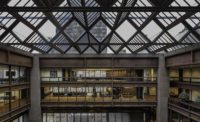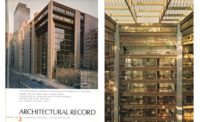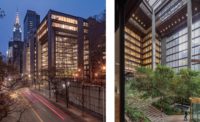The impending renovation of the 1967 Ford Foundation headquarters in Manhattan presents an unusual dilemma: the very elements that distinguish this landmark of Midcentury Modern architecture are those that threaten it. Among the earliest major works of the office of Kevin Roche John Dinkeloo Associates (KRJDA), the steel, granite, and glass edifice spares little expense to express the munificence of the Ford Foundation, which was, and remains, among the world’s most prominent philanthropic institutions. Given an AIA 25-year award in 1995 and granted landmark status in 1997, the foundation headquarters appears over and over in the pages of Architectural Record, first in a cover story from February 1968. In that piece, Jonathan Barnett wrote that the building at 320 East 43rd Street, near the United Nations, projected “ritual, hierarchy, and immense power.”
In late December, the director of the foundation, Darren Walker, invoked a similar triad of attributes when he told The New York Times that “this building is not compatible with our culture as an organization. It is hierarchical, off-putting, and inaccessible.” Beginning in October 2016, the current site will be vacated for two years for a series of renovations, led by the architectural firm Gensler and expected to cost about $190 million. These changes will include basic updates to bring the building to code, but will also involve rethinking the very spatial organization that defines its unique presence. The Ford Foundation, led by Walker, is reorienting its operations to focus on what it characterizes as a more structural approach to philanthropy, moving from simply “giving back” to addressing complicated issues of economic inequality and injustice (issues which, as Walker points out, arise from the very same “free market” that has provided the resources for the foundation’s work). The building renovation is a small but crucial aspect of this institutional recalibration, or, as he puts it, “an opportunity to reimagine the building as a public-service facility.”
The tension between magnificent display and social mission present today at the Ford Foundation was, in fact, acknowledged from the start. In the February 1968 RECORD, Barnett compared Roche’s design to the ancient “foursquare building,” meaning that the structure’s height, length, and depth were of similar dimension. A foursquare building with an interior courtyard, he continued, “is a traditional symbolic representation of the universe, and as such is an ancient symbol of power, used in religious buildings and palaces. The palace of the king of kings, the temple of the New Jerusalem, the house of the world, are the concepts this shape connotes.”
Other critics were more concerned with the contradictions that might emerge from an office building that looked like a temple. Kenneth Frampton, writing in the British publication Architectural Design, gave some icy praise to Roche Dinkeloo’s efforts before dismissing it as “a superbly organized Shangri-La housed with impeccable technique.” He called it a “house of Ivy League values and good intentions, dedicated to the dispensation of private profit for the public good, hermetically sealed in an unreal world.” Journalist William Zinsser wrote in Life magazine that the building’s introverted views and interior furnishings were hostile to office work. Crafted cabinets and desks without drawers “remind their users of how tidy they are supposed to keep them. They represent the eternal dream of architects to curb the eternal sloppiness of man.” The building, as a whole, put its own workers on display, with multiple sightlines across the glazed interior courtyard. Everyone could see what everyone else was doing.
The 174-foot-high skylit atrium is the crux of this design, central to the winning pitch that Roche made to the Ford Foundation board in 1963. It was imagined as a place where connections might be renewed—connections to both an alienated natural world and to a common organizational purpose. Roche spoke of the “community” of the office, and he and Dan Kiley, the atrium’s landscape architect, envisioned an environment where 100-foot magnolia trees would eventually match their monumental enclosure. In reality, they only survived a few years, victim to the mechanical conditions and the low humidity of the office environment. The garden’s first caretaker, Everett Conklin, gradually replaced many failed species while trying to maintain Kiley’s overall aesthetic vision. Now, it seems, landscape architect Raymond Jungles will be in charge of new planting.
In the courtyard’s design, Barnett saw a potential model for city life. The former RECORD editor, who by the time his piece appeared in the magazine was the director of the newly formed Urban Design Group for the City Planning Commission, described “a new kind of urban space that stands between the sealed environment of a modern office building and the increasingly harsh and uncontrolled urban landscape outside.” These freighted words occurred in the volatile context of protests against racial inequality in Harlem and mounting demonstrations against the Vietnam War. Mayor John Lindsay had to deal with an unwieldy city. In his new role in Lindsay’s administration, Barnett worked on a plan to develop a zoning incentive as a public amenity in office buildings that would try to replicate Roche and Kiley’s precedent of a spacious air-conditioned internal courtyard for private use. After the Ford Foundation appeared in RECORD, similar spaces began appearing throughout New York and around the world.
More difficult to replicate were the Ford Foundation’s impeccable, expensive details. Every surface became part of a total composition of discreet charm: linen and leather, English wool and oak parquet, beige rugs from Puerto Rico and furniture made of Honduran mahogany. This stately palette, combined with the magisterial atrium, created a building in which everyday office life was infused “with an almost ritualistic significance.” Barnett was also struck by the preponderance of brass details in door trim, stair rails, and other elements throughout the building. That is, he added, “One knows it is brass, but actually one thinks of it as solid gold, the ancient perquisite of priests and kings.”
Walking around the offices today, which accommodated about 360 people then and 400 now, the details and furnishings (by such designers as Warren Platner and Charles and Ray Eames) give the building its unique quality, transporting visitors back to 1967. It is also this fine-grained sensibility that presents the greatest challenge to the planned renovation. Over the years, many parts of the structure have already been rededicated toward more public uses. A private dining room on the top floor is now reserved for conferences, and parts of the lower floors function as coworking spaces for visiting grantees. Other offices have been awkwardly repurposed into staging areas for printers and IT services. But, on the whole, the achievements of KRJDA’s total design have meant a resistance to change; the offices are immured within the peculiarities of their initial conception.
Current plans by Gensler are still in development and will probably not affect the triumphant scale or its monumental elements, but it will change the executive-suite style to more of an open plan. In a recent interview with RECORD, Kevin Roche said that the transformation from the individual offices to an open floor plan was admittedly “the way office design is going.” He hoped that the renovation— on which he and his firm are acting as informal advisors—would preserve the building’s “essential features.” These include the landmarked exterior and the atrium but also, he added, the basement conference rooms and auditorium, which still summon the aura of the late 1960s, with dark brown leather seating complete with ashtrays tucked into the arms of the seats.
The gnarly question is how to preserve a work of such total, integrated design while also bringing it up to date. The foundation claims that it will make every effort to repurpose the furnishings, but they are so specific to both their midcentury origins and the peculiar layout of the building that it is difficult to imagine how the designers will manage this impossible balancing act.
Gensler’s scheme, as portrayed by the foundation, is sensible and necessary, but the peculiar appeal of the Ford Foundation was that it was a fundamentally unusual office environment. It was a built paradox, an opulent house of charity. Perhaps this previous expression cannot be preserved. The 1967 building is a remarkable work of design, but ill suited for the organization today, particularly as its new director seeks a more public and democratic image. However, it would reflect well on the Ford Foundation, and its self-awareness as an institution, if the new offices were reimagined with a confidence that matched the original.










Post a comment to this article
Report Abusive Comment